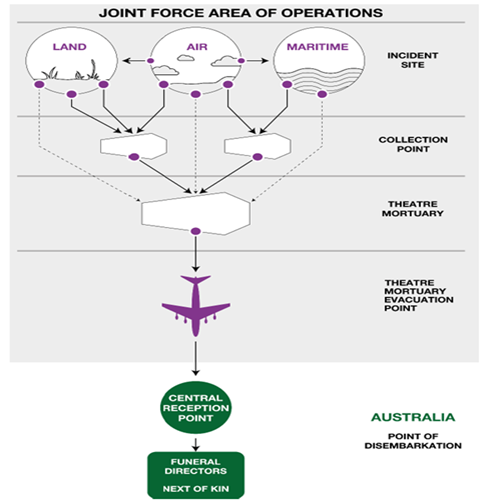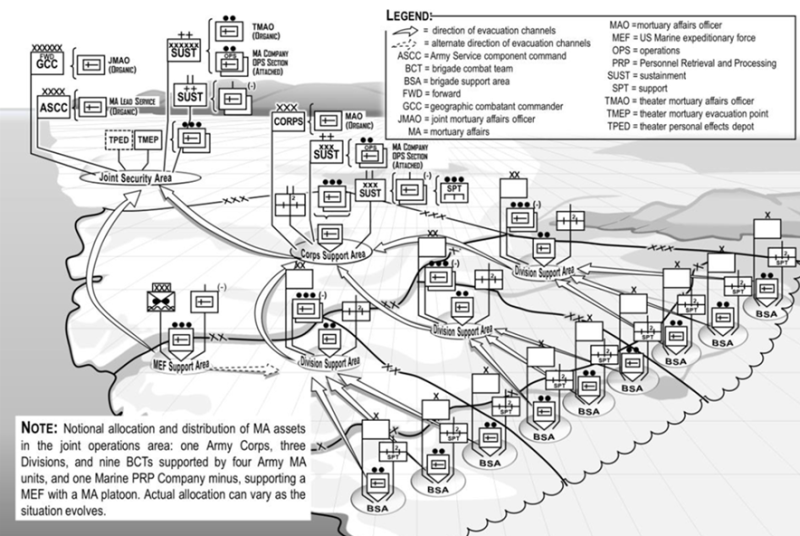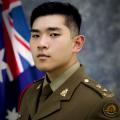Introduction
As the Army shifts our focus from counterinsurgency (COIN) operations to Large Scale Combat Operations (LSCO), there is a level of underestimation of sustainment required by logistical force elements. This includes the Mortuary Affairs (MA) capability, which to date has been underinvested in by the Australian Army. This article aims to articulate the current issues and propose a satisfactory approach for MA during LSCO.
The Australian society expects our fallen soldiers to be treated with the upmost respect. Our soldiers and their families expect the same. There were incidents from the past when our fallen soldiers were poorly managed during repatriation due to poor training of our workforce. As a result, the Australian public placed allegations against Defence which caused representational issues (Nine News, 2013 & The Daily Telegraph, 2012). It is vital that we increase our MA capabilities to ensure our soldiers can deploy, knowing that they and their families are well looked after in the event that they cannot return to their loved ones.
This will be a challenge during LSCO. The US Army’s estimation of fatalities in a combat brigade during LSCO is around 120 per day (Griffin, B., 2024). A fatality rate of this scale would almost certainly overwhelm our MA personnel and capabilities. The concurrent backload of human remains and personal effects with medical casualties will stress our supply chain. In order to ensure that we are prepared as possible to provide the level of MA expected by our personnel and the broader public, I argue that Army needs to boost its MA capability. This includes training, equipment, and the development of new SOPs.
Training for MA – in need of improvement
MA is a vital component of any operational plan. When soldiers are killed in service of their country, they and their families deserve the utmost respect for their sacrifices. The Australian people expect this of our Army and the professionalism that we have promised to deliver in our service to the nation. It needs to be executed correctly, but as it stands, we do not have the capacity to do so on a large scale. The Mortuary Affairs Officer Course (MAOC) demonstrates our knowledge gap for officers in MA. The course is based on our experiences in the Middle East and does not prepare candidates for LSCO. It lacks training for commanders at the tactical level and is focussed primarily on the strategic movement of human remains through Headquarters Joint Operations Command (HQJOC).
This training shortfall is mirrored throughout army-wide MA training. Currently, there are 4 levels of MA training within the Australian Defence Force (ADF).
- Level 1 is an awareness course online via Learn eXcel Perform (LXP).
- Level 2 is trade specific training integrated into existing courses such as initial employment training, subject promotion courses, and officer promotion courses.
- Level 3 is for commanders at the sub-unit and above levels to gain greater appreciation to make informed decisions during MA scenarios.
- Level 4 is the MAOC; a week-long residential course in Canberra.
The ADF lacks level 2 and 3 in logistical trades. This was evident from recent war fighter exercises as 17 Sust Bde supported the theatre MA development under the Operation Walker construct. These exercises demonstrated the lack of MA capability within the Army. Reasons for this include the lack of suitable training available at every level, and commanders not enforcing MA procedures. If our JNCOs are taught MA as part of their manual of Army employment training, we should expect that they will enforce MA procedures to ensure correct practices are being conducted.
As a remedy, Army would benefit from the development of a level 2 and 3 course developed for soldiers and officers within logistics to ensure MA at the tactical level is enabled. This should be driven by Joint Logistics Command and Army School of Logistic Operations. Distribution operators have been identified as the most suitable trade to execute the general logistical requirements of MA, but do not currently have any MA training as part of their employment specialisation. A new continuum of courses could assist in remedying this issue.
Our SOPs and Doctrine need review
Currently, Cbt Bde SOPs exist for MA, but these have not been reviewed since COIN operations. There is no current divisional plan or Army plan. There is a joint publication (ADF-I-1 Personnel and Health Consideration) which provides information that has not been reviewed since operations in the Middle East. It is also aimed at HQJOC led operations, not 1 (AS) Div

(Figure 1, ADF-I-1 Personnel and Health Considerations)
Figure 1 depicts the current CONOP for MA in the JFAO. Based off this, the derived concept of logistics support (COLS) determined that the Theatre Mortuary fell under the responsibility of the Force Support Group (FSG). The F Echelon would be at the incident site, supported by the collection points operated by the A2 Echelon located at the Battle Support Group (BSG).
To ensure it is relevant, MA SOP development should be led by 1 (AS) Div, not the FSG. Once there is a divisional plan, all subordinate force elements (i.e. FSG/FSU and Cbt Bde) should develop their respective SOPs based off the divisional plan. Recent experience in exercises demonstrates this to be the case: as the FSG led the theatre MA capability development in 2024 under the Operation Walker construct, the FSU SOP that was developed did not meet the needs of 1 (AS) Div.
Equipment – not fit for purpose for LSCO
Currently, the ADF utilises a contracted solution to provide human remains storage. This is not sustainable and will not allow 1 (AS) Div to operate effectively, particularly in contested littoral environments with limited prospect of civilian support. We need to be at a certain level of self-sufficiency which enables our land forces to operate independently in remote, distributed environments.
Current capabilities as per the Defence Casualty Manual (CASMAN) and the Australian Defence Force Military Police Manual suggests that the definition of a mass casualty is more than 5 casualties. The SOPs and capabilities that are in service currently culminate at 5, including disaster victim investigation (DVI) and forensic identification capabilities. By contrast, US Army have an in-service refrigerated container for human remains called the Mobile Integrated Remains Collection System (MIRCS). It can be loaded onto in-service green fleet trucks and be slung under rotary wing aircraft for movement within the battlespace. This would be a great solution for human remains storage in support of the land force. Project teams such as JP8218 should aim to develop or procure capabilities such as the MIRCS to enable land force sustainment in MA.

(Figure 2, MIRCS)
DVI and forensic capabilities are required for repatriation to ensure we send the correct remains home to families. However, getting more qualified personnel is not easy due to the career progression of military police and medical trades. DVI requires personnel within Joint military policing to reach inspector level which takes years of progression prior to meeting the pre-requisites. Forensic identification also requires officers to obtain relevant medical qualifications at the tertiary level. One solution is to mobilise reservists, state and federal police, and civilian practitioners to bolster capability. [SJM1] Additionally, to quicken the positive identification process, soldiers can provide their blood samples to their local defence health centre for identification processes post confirmation of death. It cannot be used as evidence for DFDA or criminal investigations. This is a purely voluntary process, and commanders cannot direct subordinates to provide blood samples. This then is a leadership challenge: to educate soldiers of the benefits of sharing such information.
A proposed Concept of Operation
Assuming 1 (AS) Div integrates with the US Army’s I Corps; utilising the US Army’s MA Plan to develop our own doctrines will increase interoperability with I Corps.

(Figure 3, US Army MA System)
Based off Figure 3, the proposed CONOP for 1 AS DIV could look like the below:

(Figure 4, 1 AS DIV MA System (Proposed))
In Figure 4, 1 (AS) Div is fighting with the US Army I Corps and within our own AO, we backload our HR to the Main Mortuary Affairs Collection Point (MACP) located with general logistics nodes. The Main MACP could include some DVI and forensic capabilities with support from a Role 2 Echo field hospital. Without slowing the tempo of the F Echelon, human remains and personal effects would be back loaded to the Joint Security Area, where the Theatre Mortuary Evacuation Point (TMEP) is colocated. This would be where human remains would be prepared for repatriation to the National Support Base with support from Joint Military Police and Joint Movements; coordinated by HQJOC. Identification processes could also be conducted at the TMEP if it cannot be achieved by the main MACP.
Conclusion
In this article I have argued that Army currently lacks the experience and capabilities required to execute MA functions for LSCO. The recommendations provided for the development of training, SOPs and doctrine, and the procurement of appropriate equipment, will support the execution of the proposed CONOP. This would be a satisfactory approach that meets the expectations of the Australian public, our soldiers, and their families.
The proposed CONOP was made in conjunction with feedback provided by 1 (AS) Div post 9 Force Support Battalion’s Theatre Mortuary exercise which invited multiple stakeholders ranging from different units, 1 (AS) Div, Forces Command, 17 Sust Bde and project teams. The discussion for MA needs to progress towards enabling the land force fighting in LSCO.










Thank you for defining the MA capability requirement so effectively and recommending solutions aligned with higher-level ADF concepts including the Land Domain Support System (LDSS).
As the Army transforms and optimises for littoral manoeuvre, the logistic workforce has the autonomy to continue to test, adapt and refine the conduct of MA tasks and concepts at the operational and tactical levels. This may be as part of the Advanced Collective Training schedule, unit and sub-unit level training and when available at individual level, through the MA practitioners course.
These activities may include the refinement of standardised, trusted and repeatable TTPs, rehearsals of MA activities and the development of MA tactical acumen in the logistic workforce at each echelon. The integration of the Total Workforce System (TWS) to access the critical skills not resident or sustainable in the SC7 workforce is critical to generating a scalable MA system. Integration of the TWS is likely to remain an issue that is difficult to execute, unless it is planned in detail, rehearsed and resources are invested in maintaining a network of technically proficient MA practitioners and specialists.
I encourage you to remain engaged with the development of the Land Domain contribution to the Defence MA System, through the LDSS. JLC is currently developing a Joint Warfare Note for MA. I recommend you contribute your insights, experience and recommendations to this concept.
Thank you for the feedback. I will definitely remain engaged within the MA space and continue to provide input on further developments through LFX.